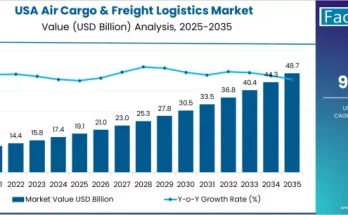The belt loaders market is witnessing notable growth as the aviation industry prioritizes operational efficiency, passenger experience, and safety. Belt loaders — vital equipment used to load and unload baggage and cargo from aircraft — play a central role in airport ground handling operations. With the increasing volume of air travel and modernization of airports worldwide, the demand for technologically advanced, eco-friendly, and automated belt loaders continues to rise.
As air transport expands globally, airports are seeking to enhance turnaround times and minimize human error. Belt loaders are increasingly being equipped with electric drivetrains, ergonomic designs, and smart sensors that improve accuracy, reduce downtime, and contribute to greener airport operations. The market’s growth reflects the aviation industry’s broader shift toward digital transformation, sustainability, and seamless ground support operations.
Market Overview
Belt loaders serve as an essential link between aircraft and airport ground services, facilitating the efficient transfer of baggage, freight, and equipment. Traditionally powered by diesel, newer models are now being introduced with hybrid and electric configurations to align with global sustainability targets and emission reduction mandates.
The increasing focus on automation and electrification is reshaping how airports manage their ground support equipment. Belt loaders are now designed with advanced safety features, modular control systems, and energy-efficient power sources, ensuring improved productivity and lower operating costs.
Furthermore, the rising number of regional and international airports is creating substantial opportunities for manufacturers to supply innovative equipment suited to different aircraft sizes and operational environments. Airlines and airport authorities are investing in ground handling modernization programs that emphasize safety, speed, and environmental responsibility — all of which are fueling the adoption of next-generation belt loaders.
Regional Insights
North America continues to lead the belt loaders market, driven by extensive airport infrastructure upgrades and strong adoption of sustainable ground support technologies. The region’s focus on energy-efficient operations, coupled with stringent environmental standards, encourages the use of electric and hybrid belt loaders. Major airport hubs are integrating automated and remotely controlled systems to streamline baggage handling and reduce manual labor dependency.
Europe is another major contributor to the global belt loaders landscape, supported by its commitment to carbon neutrality in aviation. European airports are adopting smart ground support equipment as part of broader digital airport strategies. The presence of leading manufacturers and continuous R&D efforts are further strengthening the region’s market position.
Asia-Pacific is emerging as a high-growth region, propelled by expanding airport networks, increasing passenger traffic, and government investments in aviation infrastructure. Rapid modernization efforts across countries such as China, India, Japan, and Southeast Asian nations are generating robust demand for both conventional and electric belt loaders.
In Latin America and the Middle East & Africa, ongoing airport expansions, coupled with growing investments in tourism and air freight operations, are supporting steady growth. Belt loader manufacturers are collaborating with regional suppliers and aviation authorities to offer cost-effective solutions suited for local operating conditions.
Key Trends & Forecast
- Electrification and Green Airport Initiatives:
The transition from fuel-powered to electric belt loaders is gaining momentum as airports worldwide adopt low-emission and energy-efficient ground handling equipment. Electric variants not only reduce carbon emissions but also offer lower maintenance costs and enhanced operational reliability. - Integration of Automation and IoT:
Smart belt loaders equipped with telematics, GPS tracking, and automation capabilities are improving baggage management accuracy. IoT integration enables real-time equipment monitoring, predictive maintenance, and data-driven decision-making. - Ergonomic and Safety Enhancements:
Manufacturers are designing belt loaders with improved ergonomics to ensure operator safety and reduce workplace fatigue. Features like adjustable conveyors, anti-slip platforms, and automatic braking systems are becoming standard. - Fleet Modernization Programs:
Airlines and ground handling service providers are upgrading their existing equipment fleets with advanced, low-emission, and multi-functional belt loaders. This modernization drive supports smoother ground operations and aligns with sustainability objectives. - Collaborative Innovation:
Partnerships between ground support equipment manufacturers, airport authorities, and aviation technology firms are fostering innovation. Joint ventures are enabling the development of digital platforms that integrate belt loaders into holistic airport management systems.
These trends underscore the market’s evolution toward efficiency, sustainability, and digitalization — factors that will define the future of ground handling operations.
Applications & End-Use Outlook
Belt loaders are extensively utilized across various aircraft types — from narrow-body and wide-body airplanes to regional jets and cargo planes. They form a crucial part of airport ground support systems, ensuring quick and safe transfer of baggage and cargo during flight turnaround operations.
Commercial aviation represents the largest area of application, where belt loaders contribute directly to efficient passenger service and on-time performance. As low-cost carriers and full-service airlines expand their operations, the need for reliable and energy-efficient ground handling equipment is increasing.
In the cargo and logistics sector, belt loaders are vital for managing time-sensitive freight movements, particularly in e-commerce and express delivery services. With the growth of air cargo operations, demand for durable and high-capacity loaders is expected to intensify.
Additionally, military and government aviation are adopting advanced belt loaders for operational readiness and mission-critical applications. These loaders often feature specialized designs and enhanced performance capabilities to meet defense-grade requirements.
Airports and service providers are also exploring rental and leasing models for belt loaders to reduce capital expenditure while maintaining operational flexibility. This approach allows smaller airports to access high-performance equipment without the financial burden of outright purchase.
Conclusion
The belt loaders market is evolving in response to the aviation industry’s pursuit of efficiency, sustainability, and safety. As airports continue to modernize and adopt greener technologies, the demand for innovative, automated, and energy-efficient belt loaders is set to accelerate.
Manufacturers are focusing on expanding their electric product lines, integrating smart technology, and improving design versatility to cater to diverse airport environments. The convergence of automation, digitalization, and sustainability is reshaping how ground support operations are managed — and belt loaders are at the forefront of this transformation.
Comprehensive market insights and technological evaluations can help stakeholders make informed investment decisions and align with future-ready ground handling practices. The evolution of belt loaders symbolizes the aviation industry’s broader commitment to operational excellence and environmental stewardship.
Browse Full Report – https://www.factmr.com/report/1603/belt-loaders-market



